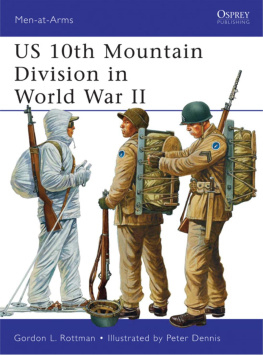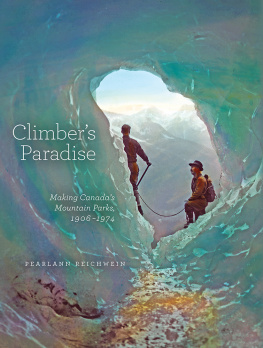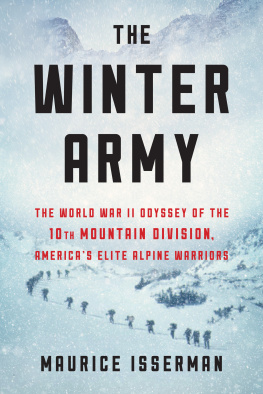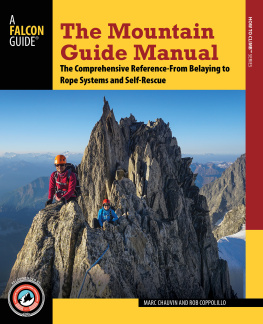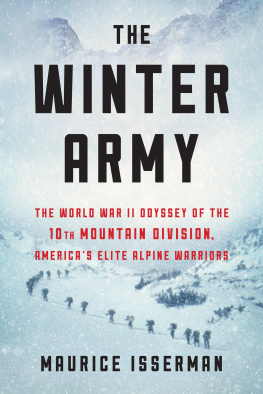
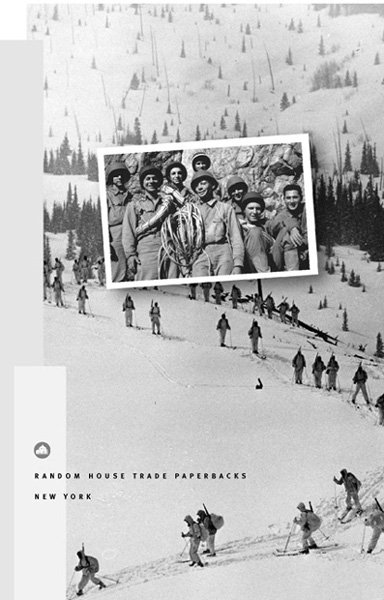
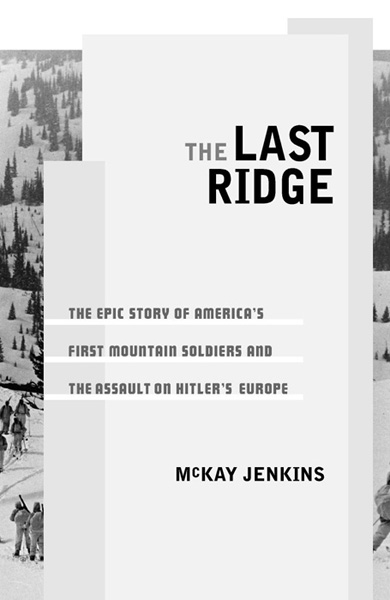
Table of Contents
For my parents, Donald and Carla Jenkins,
and my son, Steedman McKay Jenkins
The untrained mountain soldier has two foesthe enemy and themountain. But he can make a friend and ally of the mountain by learningto know it. The mountain can give him cover and concealment,points of vantage and control, even, at times, food, water, and shelter.
Proposed Manual for Mountain Troops, Mountain Training Center, October 1943
PRAISE FORTHE LAST RIDGE
The story is a good one... [Jenkins] is intent on describing the grim realities of battle. The New York Times Book Review
Researched thoroughly, written clearly and dramatized with aplomb, this presentation of the U.S. 10th Mountain Divisions WWII exploits increases our knowledge of the wars Italian theaterand of the postwar American outdoor recreation industry. Publishers Weekly
Ambrose is gone, but journalist-historian McKay Jenkins capably works the same territory in The Last Ridge, exploring individual and group heroism in a little-known corner of WWII history.... A roaring good story, with requisite run-ins with pesky brass and plenty of villainous foes to dispatch. The Hollywood Reporter
Compelling. The Denver Post
[A] gripping war story... brutal and amazing... riveting... Jenkins brilliantly blends the nuts-and-bolts battle history with the view from the front in the words of soldiers and their commanders. Omaha World-Herald
Like The White Death, Jenkins new book portrays the drama and heartache that can result when people are pitted against the environment, in this case, during wartime. Naples Daily News
Jenkins direct descriptions of combat leave no room for euphemisms.... [A] competent composition. Booklist
Engaging... a fine acccount, for WWII and outdoor adventure buffs alike. Kirkus Reviews
The Last Ridge tells a great, untold story of mountaineering and war. Its a terrific read, sharp with characters, full of real drama, and, best of all, its true. I can almost see the movie. RICHARD PRESTON, author of The Hot Zone
Stymied by army bureaucrats, forced to climb snowfields without ice axes or crampons, trained in skills that were never properly exploited, the soldiers of the 10th Mountain Division nonetheless became the stuff of myth. Without McKay Jenkins meticulous research, the achievements and eccentricities of this remarkable group of men could easily have been forgotten. Instead, they have been brought to life. ANNE FADIMAN, author of The Spirit Catches You and You Fall Down
The 10th Mountain Division was the only American Alpine unit to fight during World War II, and its heroic and daring exploits during the final months of the Italian campaign are fully documented by McKay Jenkins in this stirring, first-rate account of men at war. CARLO DESTE, author of Eisenhower: A Soldiers Life
Few have written about the Armys elite 10th Mountain Division, and no one has done so as dramatically and with such passion and insight as McKay Jenkins. The perfect war story has, at long last, found the perfect storyteller. ANDREW CARROLL, editor of War Letters: Extraordinary Correspondence from American Wars
The Last Ridge is one of the very best books yet written about any part of the World War II story. My friend the late Stephen Ambrose would be proud of this work about one of the most fascinating, yet little-known records of the mountain ski patrolsboth in war and in the peacetime that followed. SENATOR GEORGE MCGOVERN
The Last Ridge, based on skillful interviews with the survivors, is a fine account of a great story, long overdue in the telling, and very well told. PETER MATTHIESSEN, author of The Snow Leopard
LIST OF MAPS
THE ITALIAN CAMPAIGN, 19431945 72
RIVA RIDGEM. BELVEDEREM. DELLA TORRACCIA,
February 1825, 1945 158
M. GRANDECASTEL DAIANOM. DELLA SPE, March 35, 1945 199
LAKE GARDATHE FINAL BATTLES, April 26May 2, 1945 239
AUTHORS NOTE
HIGH IN THE COLORADO ROCKIES, nearly two miles above sea level and a good three-hour drive from Denver, the cracked foundations of sixty-year-old army barracks lie along the Pando valley floor like ancestral bones. Walking these grounds and the sharp valleys that rise above them, one cannot but feel the presence of the remarkable experiment that gave birth to this countrys first unit of mountain soldiers.
Like anyone who has spent time in the mountains of the American West, I have long been aware of the legacy the men of the 10th Mountain Division left after World War II. All over the Rockies, ski resorts from Aspen to Vail to Sun Valley were founded or operated, or had their ski schools directed, by division veterans returning from Europe. Paul Petzoldt, known as the highest man in the world after climbing to 26,000 feet on K2 in 1938, served the division as a mountain rescue instructor and later founded the National Outdoor Leadership School. After returning from the front in Italy, David Brower would go on to become the executive director of the Sierra Club. In the course of my own recent research, I met an inspiring division veteran named Bob Frauson, now a retired park ranger and wilderness rescue expert. The more I learned of these men, the more interested I became in what had moved them to lead such dignified lives working in and protecting our native wilderness; to me, the work so many veterans did after the war has been every bit as honorable as anything they did on the battlefieldperhaps more so, in that it provides us with an alternative vision of what excellent physical training and wilderness experience can mean to the national character. What these men learned during their astonishing years of mountain training made them far more than elite soldiers; it made them worthy of the great American landscape. Though this book is entirely about the 10th Mountain Divisions foundation, training, and wartime experience, its imaginative origins are in a postwar legacy that has gilded virtually every mountain range in the country.
The 10th Mountain Division was officially disbanded soon after the war. In 1948, the 10th Infantry Division was reactivated at Fort Riley, Kansas; it played a role in training soldiers for the Korean War and supporting NATO in Europe. In 1958, the division was once again disbanded. In 1985, it was reactivated and moved to Fort Drum in upstate New York, becoming the first division formed since 1975 and the first based in the Northeast since World War II. Units from the division have served in the Persian Gulf during Operation Desert Storm in 1991; in Somalia during Operation Restore Hope in 1994; in Haiti a year after that; and in Bosnia in 1997. As of this writing, mountain troops have recently returned from six months on the front lines in the war against the Taliban and the Al Qaeda network, most dramatically during Operation Anaconda on Afghanistans mountainous border with Pakistan. Three weeks into the war against Iraq, units from the division were beginning to move north into Iraq from Kuwait, initially to help upgrade roads and airfields.
But this book is concerned with the divisions origins and its original members. It is based primarily on more than a thousand pages of personal letters written by soldiers during their training and battle experiences, and many hundreds of pages of military and extramilitary documents written during the divisions years of training and months of fighting. All of this material is meticulously catalogued and lovingly cared for by the remarkable staff of the 10th Mountain Division Resource Center, part of the Western History and Genealogy Department of the Denver Public Library. It is to this staff that I owe my greatest debt. Debbie Gemar and Barbara Walton assisted my research in ways that are truly beyond measure; their patience, diligence, and meticulous knowledge of the divisions history made this project not only possible but a real pleasure. Bruce Hanson and others at the center, both staff and volunteer, were also helpful, guiding me through files and copying box upon box of documents.
Next page

